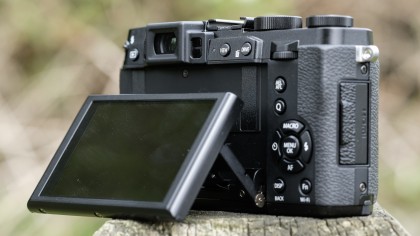Why you can trust TechRadar
While the X30 will seem very familiar to X20 users, there are some significant changes – it is noticeably taller and deeper for a start. It's still a manageable size and it can just about fit into a large jacket pocket. However, at 118.7x71.6x60.3mm it's not a great deal smaller than the Panasonic LX100 (114.8 x66.2x55.0 mm), which has a considerably larger sensor. And the Sony RX100 III (101.6x58.1x38.3mm) which has a one-inch type Exmor R CMOS sensor is actually smaller.
Fuji has improved the level of finish on the camera, giving it a higher quality coating that gives more grip. The finger grip is on the front slightly more pronounced and angular, while the thumb grip on the back is longer and higher, this makes both more effective. Consequently the X30 is very comfortable to carry in the hand without a strap, it also feels secure and unlikely to slip from your grasp.
The control layout of the new camera is also a little different from the X20's, as the dial around the navigation pad has gone and there's a customisable control ring around the lens. In addition, the navigation buttons are larger than on the X20 and there's more opportunity to customise the controls.

Many photographers are likely to use the new ring around the lens to adjust aperture, but it can also be used to control sensitivity, white balance, Film Simulation mode or drive mode.
Unlike the Canon G7 X, however, changing the function of the control ring requires a visit to the menu. It would be nice if there was a quicker route, perhaps via a dedicated button so that the ring could be used to control more options on a shot to shot basis like one the one on the G7 X can.
There's a nice level of friction to this lens ring, but it doesn't have click stops or an end point so you have to keep an eye on the screen or the EVF to know how far the settings have been adjusted.
There's a second ring on the lens for adjusting focal length. As with the X20, this ring is also used to power-up the camera. This ring is slightly stiffer to use than the customisable ring, and although there are no click stops, there are clear focal length markings and an end point. A quarter turn is enough to power-up the X30 and rotate to the longest focal length.
Sign up for breaking news, reviews, opinion, top tech deals, and more.

I found the start-up time of the X30 a little variable. It sometimes takes in the region of two seconds for the scene to appear on the main screen or in the EVF, but on other occasions it's ready for action in less than a second – that's with the same SD card installed. There were also a few occasions when the camera didn't seem to start-up after turning the lens ring. Sometimes it would start when the shutter release was depressed and on other occasions I had to turn the lens ring back and rotate it again.
In another change from the X20, the Q button which accesses the Quick Menu has been moved from the bottom right on the back to above the navigation controls and below the AEL/AFL button on the X30.
As we would expect, given that the viewfinder is the same as the one in the X-T1, the EVF provides a good clear view with plenty of detail. It's also nice and bright and displays the impact of changes made to the camera settings. However, the colours are rather vivid and I found it necessary to turn down the saturation via the screen options in the menu. Even the greens still look too vibrant.
The rear screen is good, but the Sunny Weather setting is required when shooting in bright light outside. It's useful to have the tilting screen (not as useful as a vari-angle screen would be), but I found that I used the electronic viewfinder for the vast majority of shots that I took with the camera, it just seems more natural and there's no issue with reflections.
